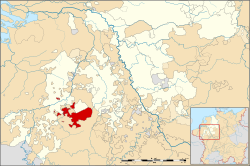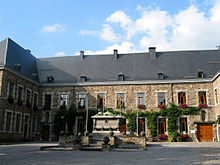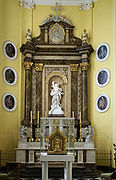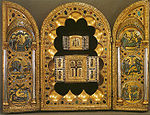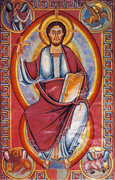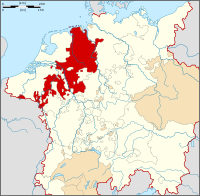- Principality of Stavelot-Malmedy
-
Imperial abbey of Stavelot-Malmedy
Principauté abbatiale de Stavelot-Malmedy (fr)
Preensdom Stavelot-Malmedy (li)
Fürstabtei Stablo-Malmedy (de)
Vorstelijke abdijen Stavelot en Malmedy (nl)Imperial Abbey of the Holy Roman Empire ← 
651–1795  →
→Stavelot-Malmedy, as at 1560, within the Lower Rhenish–Westphalian Circle Capital Stavelot Government Principality Historical era Middle Ages - Malmedy abbey founded 648 - Stavelot abbey founded 651 - Abbot Poppo of Deinze 1020–48 - Abbot Wibald 1130–58 - Annexed by France 1794 - Creation of Ourthe 1795 - Congress of Vienna* 9 June 1815 Area 600 km2 (232 sq mi) * Stavelot to  United Kingdom of the Netherlands; Malmedy to
United Kingdom of the Netherlands; Malmedy to  Prussian province of Jülich-Cleves-Berg
Prussian province of Jülich-Cleves-BergThe Principality of Stavelot-Malmedy was a principality of the Holy Roman Empire. Princely power was exercised by the Benedictine abbot of the imperial double monastery of Stavelot and Malmedy, founded in 651. At 600 km2 (230 sq mi), it was the second-smallest territory in the Empire, after the Duchy of Bouillon at 140 km2 (54 sq mi).[1] Along with Bouillon and the Prince-Bishopric of Liège, it was one of only three principalities in the region that were never a part of the Southern Netherlands,[2] all having been a part of the Lower Rhenish Imperial Circle, rather than the Burgundian Circle.[3]
In 1795 the principality was abolished and its territory was incorporated into the French département of Ourthe.[4] The Congress of Vienna in 1815 assigned Stavelot to the United Kingdom of the Netherlands[5] and Malmedy became part of the Prussian district of Eupen-Malmedy.[5] Both are currently parts of the Kingdom of Belgium — since the 1830 Belgian Revolution and the 1919 Treaty of Versailles respectively.
Contents
History
Establishment
Saint Remaclus founded the Abbey of Stavelot on the Amblève river circa 650[5][6] on lands occupying the border between the bishoprics of Cologne and Tongeren,[7] this territory previously having been part of the Frankish Empire. A charter of Sigebert III, king of Austrasia entrusted Remaclus with both monasteries of Stavelot and Malmedy a few kilometres eastwards in the Ardennes forest, "a place of horror and solitary isolation which abounds with wild beasts".[8][9][10] Sigebert granted forest land and his Mayor of the Palace, Grimoald the Elder, was charged with furnishing money to build the two monasteries and continued to foster these communities with personal gifts and means from the king.[8]
The monastery of Malmedy is considered by the historians and the hagiographers to be slightly older than the monastery of Stavelot,[11] with the town claiming foundation in 648.[12] Malmedy is listed on earlier maps than Stavelot and the commission appointed in 670 by Childeric II, in order to delimit the abbey territory, started from Malmedy (Latin: de Monasterio Malmunderio).[7] Afterwards, the territory of the abbey was increased westwards so that Stavelot became the geographical center and the capital of the principality.[7]
The site of Malmedy was probably already settled before the foundation of the abbey, despite etymology seeming to indicate Malmedy may have been unsuitable for settlement.[7] Mal(u)mund(a)-arium was "a place with winding waters" or, most probably, Malmund-arium, a "bad confluency".[7] The Warchenne was partially canalised and its banks strengthened, before which Malmedy was often flooded.[7]
The first church in Stavelot was built by abbot Godwin and, on 25 June 685, was dedicated to the saints Martin, Peter and Paul.[13] The relics of Saint Remaclus were held in this new church.[14] The abbey church in Malmedy was dedicated to St Benedict.[10]
Development and the High Middle Ages
In 747, Carloman, Mayor of the Palace, increased the abbeys' lands from his own on his abdication.[15] Throughout the ninth century, the abbeys played an important cultural role in Lotharingia, particularly thanks to abbot Christian. Around 875, the relics of St Quirinus were translated from Gasny to Malmedy Abbey after the intercession of Emperor Charles the Bald, partly to secure relics comparable to those of St Remaclus at Stavelot.[16]
Through the seventh and eighth centuries, the two abbeys followed their mission of evangelism, along with forest clearance. With the decline of the Carolingian Empire, however, the abbeys suffered the same decay as elsewhere, leaving the principality in the custody of lay abbots — temporal guardians — from 844 to 938, including Ebbo, archbishop of Rheims, Adalard the Seneschal and Reginar and Giselbert, dukes of Lorraine.[17][18][19]
Welcoming pilgrims and the sick was a part of the monks' mission. The Miracula sancti Remacli mention the xenodochium, the monastery's hospice, where poor pilgrims are granted hospitality, including food for almost eight days, whilst they make their devotions; this hospice differs from the abbey's hospital: hospitale coenobii. On 13 April 862, Lothair II of Lotharingia, while dealing with the distribution of property "ad hospital ejusdem coenobii", ordered that local tithes be paid to the hospital "absque netligentia et tarditate", an order he confirmed on 10 June 873.[13]
In December 881, Normans invaded the area, including Godfrid, Duke of Frisia, burning both abbeys and causing the monks to flee with their treasures and relics.[14][17][20][21][22] Several historical sources provide evidence on the raid of 881, which was well prepared and organised. The monks rushed to dig up the relics of Remaclus and fled to the county of Porcien in present-day Bogny-sur-Meuse in the French Ardennes; the surrounding region was largely unaffected by the invasion.[13] Stavelot and Malmedy were both burned, with the monks not returning until just before Christmas 882, with a stay in Chooz allowed them to repair the roofs of the monastic buildings. Relics from Aachen, which had been entrusted to the monks at Stavelot because of the Norman threat, were returned intact.[13] In gratitude, on 13 November 882, Charles the Fat, Carolingian emperor and king of East Francia, Alemannia and Italy, granted the abbeys the lands of Blendef, a dependency of Louveigné, and restored to them the chapel in Bra (now a part of Lierneux in Liège).[13]
In 885, Normans extracted ransom from Hesbaye and passed through the Meuse valley, marching on Prüm, causing the monks of Stavelot to flee again, finding refuge in the county of Logne and Chèvremont; the Miracula Remacli details the flight from the invaders and follows the monks' wanderings.[13] After the invasions, abbot Odilon rebuilt the ruined abbey of Stavelot; with support from bishops of Liège — including Notker, the first prince-bishop — the abbots Odilon and Werinfride rebuilt the abbeys, with new buildings, the re-establishment of the monastic community and the re-organisation of the principality; by the time of the Ottonian dynasty in the early 10th century, the abbeys were once again of suitable Imperial stature.[17] A new abbey church was built in Malmedy in 992, dedicated to St Quirinus;[16] in 1007, a parish church was consecrated to Saint Gereon.[7]
Another danger threatened the abbey — and the Western Empire — in the tenth century: the Hungarian invasions. Having been deposed as duke of Lotharingia, Conrad the Red invited the Hungarians to undermine his opponents, Bruno the Great, archbishop of Cologne, and Reginar III, Count of Hainaut. The Annales Stabulensis report: "Anno 954 Ungri populantur regiones Galliæ ... Anno 995. Victoria des Ungris" (English: In they year 954, Hungarians populate the regions of Gaul ... In the year 995, victory over the Hungarians).[13] On 1 July 960, Eraclus, bishop of Liège, driven by the fears of the time, granted the monks a location to build a refuge in Liège. Five years earlier, the victory of emperor Otto I over the Hungarians at Lechfeld proved the danger from Hungarian sack.[13]
 Henry III, Holy Roman Emperor, who was present for the 1040 consecration of the church built in Stavelot under prince-abbot Poppo of Deinze.
Henry III, Holy Roman Emperor, who was present for the 1040 consecration of the church built in Stavelot under prince-abbot Poppo of Deinze.
The key building period at the abbey of Stavelot corresponds to the rule of prince-abbot Poppo of Deinze, the second founder of the abbey,[23] who was made abbot by Holy Roman Emperor Henry II in 1020.[24] He built an imposing church over 100 metres (330 ft) in length, which was consecrated in the presence of Emperor Henry III on 5 June 1040.[13] As well as confirming the authenticity of the relics of St Quirinus at Malmedy in 1042,[16] Poppo revived the cult of St Remaclus. Poppo died in 1048; his cult, which began almost immediately,[25] focused on his resting place in the crypt. Thietmar was the lay patron who assembled carpenters and stonemasons to build the abbey church.[25] Malmedy developed around the monastery; until the end of the tenth century, the villagers used the chapel of Saint Laurent, an apsidiole of the abbey church, as their place of worship.[7]
In 1065, controversy arose when Anno II, Archbishop of Cologne, named Tegernon of Brauweiler abbot of Malmedy, on dubious authority — whilst Malmedy was in the archdiocese of Cologne, the two abbeys were linked and, thus, under the purview of the diocese of Liège, where Stavelot lay. This occurred despite several previous Imperial bulls reinforcing the position that the two abbeys should be subject to a single abbot.[26] The monks from Stavelot processed to Malmedy with the crosier and relics of St Remaclus to remind the rebellious monks of the traditional order for the abbeys that the saint had instituted. The relics and crosier were also transported to an Imperial Diet of Henry IV in Goslar. In 1066, they processed again, this time to Aachen and Fritzlar; they processed to Bitburg and Bamberg the following year. That their prayers were not answered apparently led the monks to despair that the relics were becoming impotent or that the monks were being punished by their patron; in 1067 and 1068, abbot Thierry even went to Rome to appeal to Pope Alexander II. This impasse lasted for a further three years, until Henry held court at Liège at Easter in 1071; with great ceremony, the monks processed with Remaclus's relics to meet with his legendary fellow bishop St Lambert, joined en route by the relics of St Symmetrus. Numerous miracles convinced the emperor to recognise the union of the two abbeys and reiterate the superiority of Stavelot, forcing Anno eventually to capitulate. A rejoiceful procession back to Stavelot paused en route to celebrate Mass on the banks of the Meuse; finally, the monks processed with Remaclus's relics to the abbey at Malmedy, to symbolise the restoration of his and their authority. This series of episodes is recounted in the heroic narrative of the Triumph of St Remaclus and confirmed in several contemporary sources.[14]
In 1098, Wibald was born in the hamlet of Chevrouheid, near Stavelot. Elected prince-abbot in 1130, he played a key international-level role in the religious life of the region and the abbeys. In 1138, he granted permission for the castle to be built in Logne, first mentioned in an 862 abbey charter.[27][28] In the 12th to 15th centuries, however, the abbacy experienced a slow decline. In the 14th and 15th centuries, several Imperial edicts afforded the protection of the counts of Luxembourg, firstly under Emperor Charles IV.[29]
Early Modern Age
In 1509, William of Manderscheid organised a procession to induce the recalcitrant county of Logne, a fief of the abbey, to submit to his jurisdiction. The cortège was pious, rather than fraught with tension, with Stavelot monks carrying the shrines of Remaclus and Babolene with other reliquaries and the monks of Malmedy with reliquaries of Quirinus, Just, Peter and Philip joined by parishioners from Lierneux with the relics of Symmetrus.[14] In 1521, after the castle in Logne had been dismantled, William added "Count of Logne" to the abbots' titles, with the county representing most of the western portion of the principality's territory.[28]
The abbey church served as a monastic church and as a church of pilgrimage until the French Revolution. Its imposing gatehouse tower was rebuilt in 1534;[23] its ground floor is all that remains, though the abbey church has been excavated and its layout is shown on the ground. Malmedy began to flourish particularly in the 16th century with the development of tannery; in 1544 there were only 216 houses with a thousand inhabitants, but that over tripled by 1635.[7]
After the death of abbot Christopher of Manderscheid, there was a series of absent abbots, including Maximilian Henry of Bavaria (who was also bishop of Liège and of Hildesheim), who reformed the abbey in 1656.[10] In the 17th century, Stavelot and Malmedy were major centres of tanning in Europe.[9][11][12] Other industries also known to Malmedy include cotton manufacturing, manufacture of chess sets, dominoes and gingerbread; papermaking was particularly important to Malmedy, as was the manufacture of gunpowder.[11][12] In 1659, a Capuchin convent was built in Stavelot.
Despite the abbacy's neutrality and the protection of the prince-abbots, the territory was invaded at least 50 times by troops passing through, whose depredations had disastrous consequences for the population,[12] including the 4 October 1689 razing of both Stavelot[30] and Malmedy[7][12][30] on the orders of Nicolas Catinat, general to Louis XIV of France, during the Nine Years' War.[7][12] In Stavelot, the entire town, including over 360 houses, was destroyed, leaving just the abbey and its farmyard standing;[31] Some 600 out of the 660 houses of the town were destroyed and it took more than a century to completely rebuild Malmedy.[7] Malmedy's 1601 city walls had previously been destroyed by French troops in 1658, during the 1635–59 Franco-Spanish War.[7] The wars, and passage by troops of Brandenburg-Prussia, the Dutch Republic, France and Liège, had cost the principality the sum of 2.75 million Reichsthalers, requiring the abbey to borrow 134 000 thalers from Liège and Verviers; another loan, shared amongst the communities, totalled 109 000 thalers, with annual interest of 14 161 thalers and arrears of 26 000 thalers.[31]
By the start of the 18th century the principality had lost a third of its territory, as a result of war, fires, pillage and unjust encroachments. The deputies to the Reichstag showed that, in the 16th century, the Spanish Netherlands had seized several territories and that the Bishopric of Liège had stolen over half a dozen seigneuries totalling over 2000 households, adding that the principality itself retained only 1693 households, having had 3780 households before the upheavals and that the suffering of the principality had caused some of the richest and most powerful families to emigrate. The Reichstag was moved to halve the Reichsmatrikel for the abbeys (reducing the sums and troops the abbeys needed to provide towards the Imperial army) and exempting any need for the abbeys to send troops to the Imperial army for three years, an exemption extended for four more years on 24 March 1715.[31]
Abolition
During the French Revolutionary Wars, from 1793 to 1804, the abbey was abandoned by the monks and the principality extinguished.[32] Stavelot was incorporated to the French Republic by a decree of 2 March 1793, along with Franchimont and Logne.[33] Despite opposition from local notables, Malmedy was similarly incorporated by decree of 9 Vendémiaire of the Year IV (1 October 1795).[7] Stavelot abbey itself was sacked and the church sold and demolished;[32][34] of the church just the western doorway remains, as a free-standing tower. Two cloisters — one secular, one for the monks — survive as the courtyards of the brick-and-stone 17th-century domestic ranges. The foundations of the abbey church are presented as a footprint, with walls and column bases that enable the visitor to visualize the scale of the Romanesque abbey.[23]
Geography and administration
Based largely in the Amblève and Ourthe river valleys, the principality took up a substantial proportion of what is now the arrondissement of Verviers in the province of Liège. By the time of the French Revolution, the principality was bounded to the north by the duchy of Limburg, to the south and east by the duchy of Luxembourg and to the north-west by the marquisate of Franchimont and the Condroz.[31] The principality was divided into three administrative districts: the postellerie of Stavelot, the postellerie of Malmedy and the county of Logne, totalling around 28,000 inhabitants.[6][12][31][35] The postellerie of Stavelot contained 14 communities and that of Malmedy contained the town itself and the bans of Waimes and Francorchamps. The county of Logne was divided into four quartiers: Hamoir (7 communities), Ocquier (6), Comblain (5) and Louveigné (2), with public assemblies being based in Bernardfagne. In addition, six other communities were exclaves, plus the seigneuries of Anthisnes and Vien, in the Confroz. In 1768, these two seigneuries were exchanged with Liège for Chooz, Sclessin and Ougrée.[31]
Several sources note that there were disputes between the two abbeys, with Stavelot assuming primacy over Malmedy,[27] to the latter's discontent; though new abbots were invested in Stavelot on behalf of both abbeys.[35][36] Whilst an absolute principality, in some matters the prince-abbot could consult a general assembly or états of clergy, dignitaries, prince's officers, mayors and aldermen, whose main role was to vote for taxes. Each of the three districts had its own provincial assembly and court, with a Princely Council for highly-contested cases; as a court of last resort, citizens could appeal to the Imperial Chamber Court (German: Reichskammergericht), created by Emperor Maximilian I (reigned 1508–19) on the model of the parliaments in Paris and Mechelen and headquartered in Frankfurt (1495–1527), Speyer (1527–1693) and Wetzlar (1693–1806).[2]
Shortly before the principality's extinction, it contributed just over 81 Reichsthaler per session to the Imperial economy (for the maintenance of the Imperial Chamber Court), with annual revenues of around 25 000 Rhenish gulden.[6][35][36]
Art
The abbeys at Stavelot and Malmedy commissioned some of the finest surviving works of Mosan art, one of the leading schools of Romanesque art, especially in goldsmith metalwork, which was still the most prestigious form of art. Their collections were dispersed by wars and finally the French Revolution, and works from the abbeys are now in museums across the world. The illuminated manuscript Stavelot Bible (now in the British Library) was probably the abbey's main bible, and created there by several hands over a four-year period ending in 1097,[37] and other works can be identified from the same scriptorium. The bible has been described as "a perfect microcosm of the influences and interests that gave rise to the first Romanesque painting".[38] A group of manuscripts from the less productive scriptorium at Malmedy were donated to the Vatican Library in 1816 by Pope Pius VII,[39], including the Malmedy Bible and two lectionaries from about 1300.[40] Malmedy illuminations show particular closeness with metalwork styles.[41]
Abbot Wibald (ruled 1130–58) was an important Imperial minister and diplomat, and regarded as one one of the greatest patrons of Mosan art in its best period, although much of the evidence for this is circumstantial. Some of his surviving letters discuss works which may be identifiable with existing pieces, and an "aurifaber G" who some have identified with Godefroid de Claire / of Huy, a shadowy figure to whom many masterpieces are attributed. Several important commissions were certainly placed by Wibald with Mosan workshops of goldsmiths and metalworkers, and other works later connected with Stavelot are also presumed to have been commissioned by him.[42] The works, mostly including champlevé enamels of very high quality, include the Stavelot Triptych, a portable altar reliquary for two fragments of the True Cross, c. 1156, (now in The Morgan Library & Museum in New York),[32][43][44] the "Stavelot Portable Altar" of 1146 and a head-shaped reliquary of Pope Alexander II, c. 1150, possibly by Godefroid (both now Cinquantenaire Museum, Brussels).[45] A gold relief retable of the Pentecost (1160–70) is in the Musée de Cluny, Paris, but an important and more elaborate retable of Saint Remaclus, of about 1150 and extending about nine square metres, was broken up at the French Revolution, and only two round enamel plaques survive, in Berlin and Frankfurt,[46] though a 17th century drawing survives in Liège.[42][47]
Christ in Majesty from the Stavelot BibleRetable with the Pentecost from Stavelot, c. 1170Coat of arms
The coat of arms, granted to the town of Stavelot in 1819, is also the coat of arms of the abbey — parted fesswise between an image of St Remaclus and the wolf, which in Stavelot's founding legend carried bricks for the building of the abbey after having killed Remaclus's donkey.[10][32][48]
See also
References
- This article makes use of the articles Principauté de Stavelot-Malmedy, Abbaye de Stavelot and Malmedy from the French Wikipedia and the article Stavelot on the English Wikipedia.
- ^ History of the Duchy of Bouillon on Heraldica; Last accessed 26 December 2009.
- ^ a b (French) André Uyttebrouck, "Une Confédération et trois principautés", in La Wallonie, le Pays et les Hommes (edited by Rita Lejeune), La renaissance du livre, 1975, volume 1, pages 215–44, 235.
- ^ (German) Hernach volgend die zehen Krayß (1532)
- ^ (French) Alexandre Ferrier de Tourettes, Guide pittoresque et artistique du voyageur en Belgique, Société Belge de Librairie, etc, 1838, page 241
- ^ a b c (French) History on the official website of Stavelot. Last accessed 26 December 2009.
- ^ a b c (French) Stavelot in the Encyclopédie méthodique, Panckoucke, 1788
- ^ a b c d e f g h i j k l m n Malmedy on Flags of the World, notably "Aperçu historique de Malmedy" (French) by Robert Christophe, in Malmedy. Art et Histoire 87–97, referenced there. Both sites last accessed 2 January 2010.
- ^ a b Pierre Riché (translated by Michael Idomir Allen), The Carolingians, University of Pennsylvania Press, 1993, ISBN 978-0-812-21342-3, pages 21–2
- ^ a b (French) Stavelot in the Dictionnaire géographique de la province de Liége (edited by Dr Meisser), L'Établissement Géographique, Faubourg de Flandre, 1831
- ^ a b c d (French) Jean-Baptiste Chrystin, Les délices des Pays-Bas, CM Spanoghe, 1785, volume 4, pages 169–74
- ^ a b c Malmedy in the 1911 Encyclopædia Britannica
- ^ a b c d e f g Growth and History, Malmedy official website. Last accessed 26 December 2009.
- ^ a b c d e f g h i (French) Philippe George, Reliques et Arts Precieux en Pays Mosan, Éditions du CEFAL, 2003 ISBN 978-2-871-30121-9, pages 127–8
- ^ a b c d Sarah Blick and Rita Tekippe (eds), Art and Architecture of Late Medieval Pilgrimage in Northern Europe and the British Isles, Brill, 2004, ISBN 978-9-004-12332-8, pages 729, 739–43. The sources contemporary to Triumph of St Remaclus are listed in footnote 233 on page 742; the 1509 procession is cited in footnote 169 on page 729 as being referenced in A Delescluse (1894), "Une procession à Stavelot en 1509", Bulletin de la Société d'Art et d'Histoire du Diocèse de Liège VIII, pages 367–70.
- ^ Pierre Riché (translated by Michael Idomir Allen), The Carolingians, University of Pennsylvania Press, 1993, ISBN 978-0-812-21342-3, page 59
- ^ a b c (German) St Quirinus of Rott, Parish website of St Anthony of Roetgen-Rott and, cited therewithin, Ludwig Drees (1973), "Der Kampf mit dem Drachen, Die Legende des Hl. Quirinus von Malmedy", in: Zwischen Venn und Schneifel, volume 9. Website last accessed 26 December 2009.
- ^ a b c (French) René-Norbert Sauvage (1928), review of François Baix's 1924 Étude sur l'abbaye et principauté de Stavelot-Malmédy, in Revue d'histoire de l'Église de France 14(63):224–5.
- ^ Regnier I of Hainault, Burke's Peerage & Baronetage, 106th Edition, page 1929, cited in Voyer & Bedard Family History and Ancestry; website last accessed 26 December 2009.
- ^ Giselbert, duke of Lotharingia, 928–939, Foundation for Medieval Genealogy. Last accessed 26 December 2009.
- ^ Janet Nelson and Timothy Reuter, The Annals of Fulda, Manchester University Press, 1992, ISBN 978-0-719-03458-9, volume 2, page 90
- ^ (French) Louis Dieudonné Joseph Dewez, Abrégé de l'histoire belgique, Adolphe Stapleaux, 1817, pages 163–4
- ^ (French) Philippe Mignot, "Le peuplement médiéval au sud de la Meuse. Le cas de Logne" in Mélanges d'archéologie médiévale (edited by Danielle Sarlet), Ministère de la Région Wallonne / Mardaga 2006, ISBN 978-2-870-09938-4, pages 148–49
- ^ a b c Archæological remains, Abbaye de Stavelot. Last accessed 26 December 2009.
- ^ St Poppo in the Catholic Encyclopedia
- ^ a b The Vita Popponis, which detailed the miracles that occurred in his name, specifically asserted that Stavelot might rejoice in having a saint, as Tours rejoiced in its Saint Martin.
- ^ (French) Leclercq (editor) Liste chronologique des édits et ordonnances de la principauté de Stavelot et de Malmédy, de 650 à 1793, Em Devroye, 1852. For example: "Sans date (950, Villers; vers 944, Bertholet) — Diplôme de Otton I, roi des Romains, accordé à l'abbé Odilon, par lequel il laisse aux religieux des monastères de Stavelot et de Malmédy la libre faculté de choisir un abbé, chargé seul de l'administration des deux monastères." (English: "Undated (950, Villers; ca 944 Bertholet) — Bull from Otto I, King of the Romans, granted to abbot Odilon, under which he grants to the religious community of the monasteries of Stavelot and Malmedy the free ability to choose an abbot, charged with the sole right of administration of the two monasteries." page 8). More recently to the time, Emperor Henry IV had confirmed this in Trier in 1065: "... déclarant que les deux monastères doivent être soumis à l'autorité d'un seul abbé." (English: "... declaring that the two monasteries must submit to the authority of a single abbot." page 10)
- ^ a b (French) Leclercq (editor) Liste chronologique des édits et ordonnances de la principauté de Stavelot et de Malmédy, de 650 à 1793, Em Devroye, 1852: "5 juin 1138, à Stavelot — Édit de Wibald, abbé de Stavelot, qui ordonne la restauration du château de Logne et la translation du village du même nom dans la vallée qui avoisine le château, du côté de l'est." (English: "5 June 1138, at Stavelot — Edict of Wibald, abbot of Stavelot, ordering the restoration of the castle of Logne and the translation of the village of the same name in the valley around the castle, to the east." page 13)
- ^ a b (French) Liège, Arrondissement de Huy, vol 16(1) from the series Le patrimoine monumental de la Belgique (edited by Danielle Sarlet), Ministère de la Région Wallonne / Mardaga, 1992, ISBN 978-287-009487-7, page 411; this piece contains a citation to Jean Yernaux, Histoire du comté de Logne. Étude sur le passé politique, économique et sociale d'un district ardennais, Liège-Paris 1937, pages 13–48.
- ^ (French) Leclercq (editor) Liste chronologique des édits et ordonnances de la principauté de Stavelot et de Malmédy, de 650 à 1793, Em Devroye, 1852. For example: "25 août 1349, à Bastogne — Diplôme de Charles IV, roi des Romains, qui enjoint en sa qualité d'avoué héréditaire de l'abbaye de Stavelot, à tous les officiers du comté de Luxembourg, de prendre sous leur protection l'abbé, son église et les biens qu'elle possède, et de leur en assurer la jouissance." (English: "25 August 1349, in Bastogne — Bull of Charles IV, King of the Romans enjoining, in his capacity as hereditary officer of the abbey of Stavelot, all the officers of the county of Luxembourg to take under their protection the abbot, his church and all the goods they possess and to assure their tenure." page 14). This protection was reiterated in 1384 by Wenceslaus, King of the Romans and in 1417 by Sigismund, Holy Roman Emperor, themselves both dukes of Luxembourg (page 15). Habsburg Emperor Leopold I, also duke of Luxembourg, again reiterated this protection by an edict of 1674 (page 46).
- ^ a b (German) Tony Kellen, Malmedy und die preussische Wallonie, Fredebeul & Koenen, 1897 (excerpt)
- ^ a b c d e f Arsène de Noüe Études historiques sur l'ancien pays de Stavelot et Malmedy, L Grandmont-Donders, 1848, pages 321–5
- ^ a b c d Stavelot on Flags of the World. Last accessed 26 December 2009.
- ^ (French) Collection complète des lois décrets, ordonnances, réglemens avis du conseil-d'état, A Guyot et Scribe, 1834 volume 5, page 178
- ^ (French) Exposé fidéle des raisons qui ont retardé l'Exécution de la Sentence Impériale de Wetzlaer, au sujet de l'Insurrection Liégoise, avec les pièces justificatives. (1790) pages 84–7
- ^ a b c Anton Friedrich Büsching (translated by P Murdoch, 1762), A new system of geography, volume 4, pages 363–4
- ^ a b (French) Malmedy in the Encyclopédie méthodique, Panckoucke, 1788
- ^ Stavelot Bible in The British Library Catalogue of Illuminated Manuscripts. Last accessed 26 December 2009.
- ^ Western painting: Dark Ages and medieval Christendom: The Meuse Valley in the Encyclopædia Britannica. Last accessed 26 December 2009.
- ^ Paul Saenger, Space between words: the origins of silent reading, Stanford University Press, 2000, ISBN 978-0-804-74016-6, page 192
- ^ Judith Oliver, Gothic manuscript illumination in the diocese of Liege (c. 1250 – c. 1330), Uitgeverij Peeters, 1988, ISBN 978-9-068-31131-0 page 310
- ^ (French) Marie-Rose Lapière, La lettre ornée dans les manuscrits mosans d'origine bénédictine, XIe – XIIe siècles, Librairie Droz, 1981, ISBN 978-2-251-66229-9, pages 293–96
- ^ a b "Wibald", Grove Art. Accessed January 5, 2010
- ^ Stavelot Reliquary on Corsair, the Online Catalog of The Morgan Library & Museum. Last accessed 26 December 2009.
- ^ Stavelot Reliquary on the Christian Iconography website of J. Richard Stracke, emeritus professor of English at Augusta State University. Last accessed 26 December 2009.
- ^ Hanns Swarzenski, Monuments of Romanesque Art; The Art of Church Treasures in North-Western Europe, Faber and Faber, 1975, ISBN 978-0-571-10588-5, pages 67 and 69, and plates: photos here; another image
- ^ Low Countries, 1000–1400 A.D., Heilbrunn Timeline of Art History, Metropolitan Museum of Art. Last accessed 26 December 2009.
- ^ Godefridus Snoek, Medieval piety from relics to the Eucharist: a process of mutual interaction, Brill, 1995, ISBN 978-9-004-10263-7, pages 210–11
- ^ Max Servais, Armorial des Provinces et des Communes de Belgique, Crédit Communal de Belgique, Brussels, 1955, cited in Coat of arms of Stavelot on Heraldry of the World, last accessed 26 December 2009.
External links
Wikimedia Commons has media related to:  Lower Rhenish–Westphalian Circle (1500–1806) of the Holy Roman Empire
Lower Rhenish–Westphalian Circle (1500–1806) of the Holy Roman EmpireEcclesiastical Prelates Secular Counts
and lordsfrom 1500Bentheim · Bronkhorst (until 1719) · Diepholz · East Frisia (until 1667) · Horne3 (until 1614) · Hoya · Lingen3 · Lippe · Manderscheid (until 1546) · Moers (until 1541) · Nassau (Diez · Hadamar · Dillenburg (until 1664)) · Oldenburg (until 1777) · Pyrmont · Ravensberg3 · Reichenstein · Rietberg · Salm-Reifferscheid · Sayn · Schaumburg · Tecklenburg · Virneburg · Wied · Winneburg and Beilstein · Zimerauff?from 1792Anholt · Blankenheim and Gerolstein · Gemen · Gimborn · Gronsfeld · Hallermund · Holzapfel · Kerpen-Lommersum · Myllendonk · Reckheim · Schleiden · Wickrath · Wittemstatus
uncertainCities 1 from 1792. 2 until 1792. 3 without Reichstag seat. ? status uncertain. Categories:- Imperial abbeys
- Former principalities
- Former polities in the Netherlands
- States of the Holy Roman Empire
- States and territories established in 651
- States and territories disestablished in 1795
- 1795 disestablishments
- History of Belgium
- Lower Rhenish-Westphalian Circle
Wikimedia Foundation. 2010.

